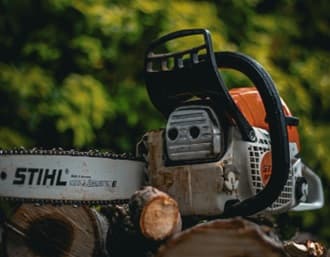As an Amazon Associate, this site earns commissions from qualifying purchases. For more information click here.
Chainsaws are invaluable tools for homeowners, arborists, and professionals alike, enabling efficient tree cutting, branch trimming, and firewood preparation. At the heart of these powerful machines lies the engine, a complex assembly of components that requires regular maintenance and occasional repair to ensure peak performance.
Key Takeaways:
- Regular maintenance and prompt troubleshooting are crucial for ensuring optimal chainsaw engine performance and longevity.
- Understanding common engine problems and their causes empowers chainsaw owners to address issues effectively and prevent costly repairs.
- Prioritizing safety when conducting engine repairs or maintenance tasks is paramount to avoid accidents and injuries.
Common Chainsaw Engine Problems
Most chainsaws are equipped with two-stroke engines due to their lightweight design and high power output. These engines typically comprise a cylinder, piston, crankshaft, carburetor, ignition system, and exhaust system. The operation of a chainsaw engine hinges on the precise coordination of air intake, fuel delivery, compression, combustion, and exhaust expulsion.
Starting Issues
Chainsaws often exhibit reluctance or failure to start, attributed to factors such as a fouled spark plug, clogged air filter, stale fuel, or improper starting procedure. Ensuring a clean spark plug, replacing the air filter regularly, using fresh fuel, and following the correct starting procedure can help mitigate starting issues and ensure smooth engine ignition.
Loss of Power
Gradual or sudden loss of engine power can stem from issues like a worn piston ring, carbon buildup in the exhaust port, restricted fuel flow, or inadequate lubrication. Regularly checking and replacing worn components, cleaning carbon deposits, ensuring proper fuel flow, and maintaining adequate lubrication can help restore engine power and performance.

Overheating
Excessive heat generation in the engine can result from factors like a lean fuel mixture, insufficient lubrication, prolonged operation under heavy loads, or restricted airflow. Monitoring fuel mixture ratios, ensuring proper lubrication, avoiding prolonged heavy-duty use, and maintaining clear airflow around the engine can prevent overheating and potential damage to internal components.
Stalling or Rough Running
Chainsaws may stall, idle erratically, or exhibit rough running behavior due to carburetor issues, fuel line blockages, ignition system malfunctions, or air leaks. Regularly inspecting and cleaning the carburetor, clearing fuel lines, checking the ignition system, and sealing any air leaks can help resolve stalling and rough running issues, ensuring smooth engine operation.
Excessive Smoke
An abnormal amount of smoke emitted from the exhaust indicates problems such as an oil-fouled spark plug, incorrect fuel mixture, worn piston rings, or inadequate lubrication. Addressing issues such as replacing the spark plug, adjusting fuel mixture ratios, inspecting and replacing worn piston rings, and maintaining proper lubrication can help reduce smoke emission and improve engine efficiency.
Sometimes the problem is not related to the engine but the blade. In this case, you may need to sharpen the chainsaw blade to get it running again.
Troubleshooting Chainsaw Engines
Applying a systematic approach to diagnose engine problems can significantly streamline troubleshooting efforts. By creating a flowchart that guides you through a series of logical steps based on observed symptoms, you can efficiently identify and address issues.
Compression Testing
Employing a compression tester allows you to measure cylinder compression, providing valuable insights into engine health. Abnormal compression readings can indicate problems such as worn piston rings, cylinder scoring, or head gasket leaks, prompting targeted repairs or maintenance.
Vacuum Testing
Conducting a vacuum test is an effective method for detecting air leaks in the engine’s intake system. Using a vacuum gauge and appropriate adapters, you can assess the integrity of carburetor gaskets, crankshaft seals, and other components prone to vacuum leaks, facilitating timely repairs to prevent air infiltration and optimize engine performance.
Fuel System Pressure Testing
Evaluating the fuel system’s integrity through pressure testing is essential for identifying potential issues affecting fuel delivery. By employing a fuel pressure gauge, you can pinpoint problems such as fuel pump malfunction, clogged fuel filter, or leaking fuel lines, enabling targeted repairs or replacements to restore proper fuel flow and combustion efficiency.
Ignition System Analysis
The ignition system plays a critical role in engine operation, necessitating thorough analysis to ensure optimal performance. Conducting spark plug inspection, ignition coil resistance testing, and spark strength measurement allows you to pinpoint ignition-related problems.
This includes causes such as fouled spark plugs, faulty ignition coils, or weak spark output, facilitating necessary adjustments or component replacements to maintain consistent spark delivery and ignition timing.
Carburetor Adjustment and Rebuilding
Mastering the art of carburetor tuning is essential for optimizing engine fuel-air mixture and throttle response. By adjusting idle speed, air-fuel mixture ratio, and throttle sensitivity, you can fine-tune engine performance to suit specific operating conditions.
Periodic carburetor disassembly and cleaning are crucial for removing varnish, debris, and other contaminants that can impede fuel flow and disrupt combustion. Rebuilding the carburetor with new seals, gaskets, and diaphragms ensures reliable operation and prevents fuel system issues.
Chainsaw Engine Maintenance
By following these maintenance tips and performing regular checks, chainsaw owners can enjoy reliable performance and efficient cutting for years to come.
Proper Fuel Mixture
Ensuring the correct fuel mixture is essential for optimal engine performance and longevity. Use a high-quality two-stroke oil formulated specifically for chainsaws and mix it with fresh unleaded gasoline at the recommended ratio, typically 50:1 or 40:1. This ensures proper lubrication of engine components and prevents issues such as piston scuffing and carbon buildup.
Air Filter Maintenance
The air filter plays a crucial role in preventing debris and dust from entering the engine and compromising combustion efficiency. Regularly clean or replace the air filter according to the manufacturer’s recommendations to maintain optimal airflow. A clogged air filter restricts airflow, leading to decreased engine power and potential overheating.
Cooling System Care
Proper engine cooling is vital for preventing overheating and minimizing wear on internal components. Keep the engine’s cooling fins clean and unobstructed to facilitate heat dissipation. Clear away any debris, such as sawdust or leaves, that may accumulate around the cooling fins and engine housing. This simple maintenance task helps maintain consistent engine temperature and prolongs the lifespan of critical engine parts.
Chain Lubrication
Adequate chain lubrication is essential for smooth operation and prolonging the lifespan of the chain and bar. Regularly check the oil reservoir level and adjust the automatic oiler settings to ensure proper lubrication during operation. Insufficient lubrication can lead to increased friction, premature wear, and potential chain derailment. Use high-quality chain oil recommended by the manufacturer to ensure optimal lubrication and chain performance.
Chain Tension Adjustment
Proper chain tension is crucial for safe and efficient chainsaw operation. Monitor chain tension frequently, especially during extended use, and adjust it as needed to prevent chain slippage, excessive wear, and potential kickback incidents.
A loose chain increases the risk of kickback, while an overly tight chain can strain the engine and cause premature wear on the chain and bar. Follow the manufacturer’s guidelines for chain tension adjustment to ensure safe and effective cutting performance.
Regular Inspection
Conducting routine visual inspections of the engine, chainsaw chassis, and cutting components is essential for identifying potential issues before they escalate. Check for signs of wear, damage, or fluid leaks, paying particular attention to critical areas such as the chain, bar, sprocket, and engine housing.
Addressing issues promptly helps prevent further damage and ensures continued safe and efficient operation of the chainsaw. Regular maintenance and inspection are key to maximizing chainsaw performance, prolonging its lifespan, and ensuring safe operation.
How Long Does a Chainsaw Engine Last?
The lifespan of a chainsaw engine can vary significantly depending on several factors, including the quality of the engine, how well it is maintained, the frequency and intensity of use, and operating conditions.
With proper maintenance and care, a high-quality chainsaw engine can last for thousands of hours of use. Some professional-grade chainsaws are built to withstand heavy-duty use and may last for decades if properly maintained.
On the other hand, lower-quality or poorly maintained engines may have a shorter lifespan. Lack of regular maintenance, such as neglecting oil changes, failing to clean air filters, or using improper fuel mixtures, can accelerate wear and lead to premature engine failure.
Generally, chainsaw engines can last anywhere from several years to over a decade with proper care. Regular maintenance, including oil changes, air filter cleaning/replacement, and proper fuel mixture, can help extend the lifespan of the engine and ensure reliable performance over time. Additionally, avoiding overheating, excessive strain, and other forms of mechanical stress can contribute to prolonging the engine’s longevity.
Expert Tips for Chainsaw Engine Care
Prior to engaging in heavy cutting tasks, it’s essential to allow the engine to warm up for a few minutes. This practice ensures optimal oil flow and lubrication to critical engine components, reducing friction and minimizing wear during operation. A brief warm-up period also helps stabilize engine performance, enhancing overall efficiency and prolonging engine life.
Avoid Ethanol Fuel
Whenever possible, opt for ethanol-free gasoline to fuel your chainsaw. Ethanol-blended fuels, commonly found at gas stations, can lead to various issues such as fuel system corrosion, carburetor gumming, and starting difficulties. By using ethanol-free gasoline, you can mitigate these potential problems and maintain the integrity of your chainsaw’s fuel system, ensuring smooth operation and reliable performance.
Sharpen Chains Regularly
A sharp cutting chain is essential for efficient and safe cutting operations. Make it a habit to sharpen your chainsaw chain regularly using a chainsaw file or electric sharpener. Dull chains not only require more effort to cut through wood but also impose additional strain on the engine, leading to decreased performance and increased wear.
By maintaining a sharp cutting chain, you not only improve cutting efficiency but also reduce stress on the engine, prolonging its lifespan and ensuring consistent performance.
Strategic Cooling Breaks
During prolonged cutting sessions, it’s important to take periodic breaks to allow the engine to cool down. Continuous operation under heavy loads can cause the engine to overheat, potentially damaging critical components and reducing longevity.
By incorporating strategic cooling breaks into your cutting routine, you give the engine time to dissipate heat and maintain optimal operating temperature, minimizing the risk of overheating and extending engine life.
Store Properly
Proper storage is key to preserving the condition and performance of your chainsaw engine during periods of non-use. Store the chainsaw in a dry, well-ventilated area away from direct sunlight and moisture. Ideally, use a protective case or cover to shield the chainsaw from dust, debris, and environmental elements.
Proper storage not only prevents corrosion and rust but also ensures that the chainsaw is ready for use when needed, without the risk of damage or deterioration.
Professional Servicing
When faced with complex engine issues or uncertainty about proper maintenance procedures, it’s advisable to seek assistance from certified chainsaw technicians or authorized service centers.
Professional servicing ensures that your chainsaw receives expert diagnosis, repair, and maintenance, maximizing performance, reliability, and longevity. By entrusting your chainsaw to experienced professionals, you can address any underlying issues effectively and enjoy peace of mind knowing that your equipment is in capable hands.
Conclusion
Chainsaw engine repair and maintenance require a blend of technical knowledge, practical skills, and meticulous attention to detail.
Remember that safety should always be a top priority when working with chainsaws, and never hesitate to seek professional assistance for challenging repairs or maintenance tasks. With proper care and diligence, your chainsaw engine will continue to deliver reliable performance, making light work of your toughest cutting jobs.

I love the outdoors and all the tools for maintaining gardens, yards and lawns. The only thing I am more passionate about is sharing what I know about garden and outdoor equipment.


